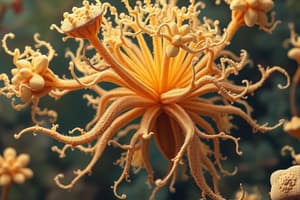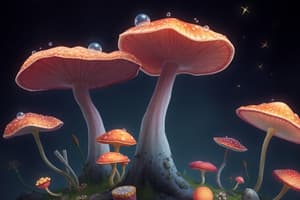Podcast
Questions and Answers
What is a blastula?
What is a blastula?
A hollow sack of cells with fluid inside.
What is cellulose?
What is cellulose?
Contained in the plant cell walls.
How are fungi classified?
How are fungi classified?
By Structure and Reproduction.
What are the four Eukaryotic kingdoms?
What are the four Eukaryotic kingdoms?
How many subsections of the Protista kingdom are there?
How many subsections of the Protista kingdom are there?
Which kingdom is multicellular, heterotrophic, and lacks cell walls?
Which kingdom is multicellular, heterotrophic, and lacks cell walls?
Which kingdom consists of heterotrophs, parasites, and decomposers?
Which kingdom consists of heterotrophs, parasites, and decomposers?
How do fungi reproduce?
How do fungi reproduce?
The blastula is found in which Eukaryotic kingdom?
The blastula is found in which Eukaryotic kingdom?
Which kingdom alternates haploid and diploid cells?
Which kingdom alternates haploid and diploid cells?
What is the pistil?
What is the pistil?
What parts are in the stamen?
What parts are in the stamen?
What is the function of the petal?
What is the function of the petal?
What is the difference between Kingdom Plantae and Animalia?
What is the difference between Kingdom Plantae and Animalia?
Flashcards are hidden until you start studying
Study Notes
Eukaryotic Kingdoms Overview
- Eukaryotic Kingdoms consist of Protista, Fungi, Plantae, and Animalia.
- Protista has three subsections, illustrating its diversity.
Key Terms
- Blastula: A developmental stage in animals, characterized by a hollow sack of cells with internal fluid.
- Cellulose: A polysaccharide that forms the structural component of plant cell walls, providing rigidity and support.
Classification of Organisms
- Fungi are classified based on their structure and reproduction methods.
- Animalia Kingdom: Multicellular, heterotrophic organisms that lack cell walls, showcasing complex life forms.
- Fungi Kingdom: Composed of heterotrophic organisms that act as parasites and decomposers, playing a critical ecological role.
Reproduction
- Fungi can reproduce sexually and asexually, displaying a variety of reproductive strategies.
Plant Structure
- Pistil: The female reproductive part of a flower.
- Stamen: The male reproductive organ in flowers, consisting of the anther and filament.
- Petals: Serve the primary function of attracting pollinators to facilitate reproduction.
Lifecycle Differences
- Plantae Kingdom: Exhibits an alternating lifecycle between haploid and diploid cells, crucial for genetic diversity and adaptation.
- Differences between Plantae and Animalia: Distinguishable by plants being non-motile and autotrophic, while animals are motile and heterotrophic.
Studying That Suits You
Use AI to generate personalized quizzes and flashcards to suit your learning preferences.



